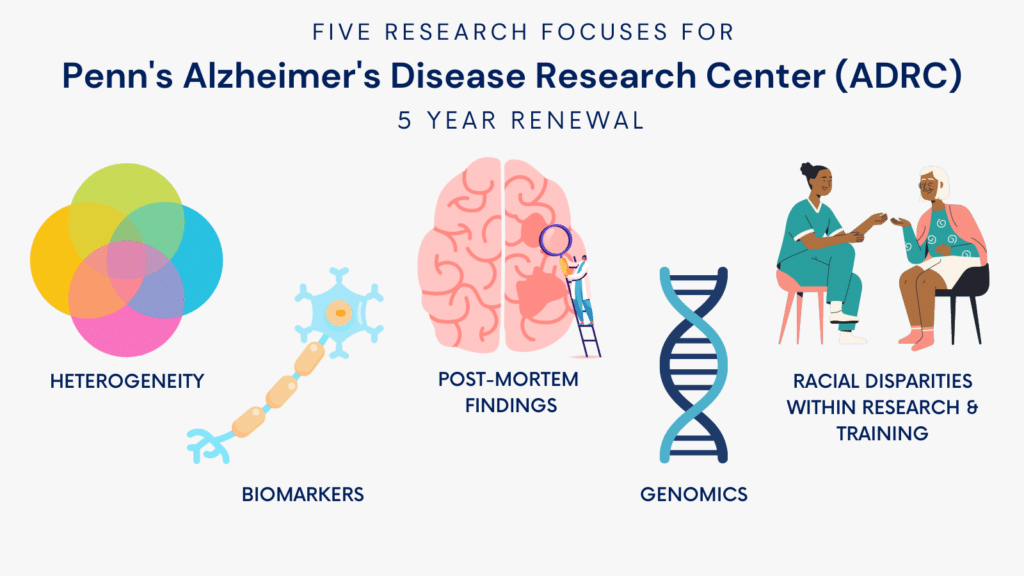By Meghan McCarthy
Penn’s Alzheimer’s Disease Research Center (ADRC) has been granted a five-year renewal by the National Institute on Aging (NIA). The infrastructure grant amounts to over $16 million to support basic and clinical research in Alzheimer’s disease and related dementias (ADRDs).
With this renewal, the ADRC, led by David Wolk, MD, Jason Karlawish, MD, and Eddie Lee, MD, PhD, is striving to advance research, training, and outreach efforts and to further develop techniques for diagnosing and treating ADRDs.
Specifically, the ADRC will focus on research pertaining to heterogeneity, biomarkers, post-mortem findings, genomics, and racial disparities within research.
Each individual’s experience of an ADRD is unique, or heterogenous.
For example, some people develop Alzheimer’s disease dementia at 60 years old while others don’t develop it until 85. People with the same disease may experience different symptoms. A better understanding of these differences will lead to more specific treatment plans for patients, help treat ADRD in the earlier stages of disease, and improve researchers’ ability to determine whether an experimental drug is effective or not.
“Alzheimer’s disease is an extremely heterogenous condition,” said Dr. Wolk. “Heterogeneity may reflect difference in disease mechanisms, requiring different interventions tailored to the individual.”
This heterogeneity is a primary focus of research for the ADRC.
Other key ADRC research focuses are biomarkers, which are molecules within your body that can be measured to indicate disease, and post-mortem findings, which include comparing the diagnosis received during life to the disease found in the brain tissue after death.
There are several biomarkers, such as proteins known as amyloid and tau, that indicate a person has Alzheimer’s disease.
In particular, the ADRC is interested in researching blood markers of Alzheimer’s disease. If Alzheimer’s disease could be detected through a blood test, patients would no longer have to receive a lumbar puncture — a process many people find unpleasant — to test for the disease. Dr. Wolk believes these blood tests will available in the near future.
Investment in post-mortem analyses will also improve what is known about biomarkers.
In post-mortem analysis, ADRC researchers check if the results of biomarker tests done during life match the disease they find when looking at the brain tissue under a microscope and through a scanner.
“Post-mortem work informs our knowledge of biomarkers and improves precision of disease progression. It allows us to validate our biomarkers,” said Dr. Wolk.
Other ADRC research endeavors include an investment in genomics, which is the study of how an individual’s genes impact their health, and innovative interventions, such as transcranial direct current stimulation (tDCS).
The ADRC also received a $3.5 million state grant from Pennsylvania’s Department of Health to address underrepresentation of black adults in ADRD research.
Black and African Americans are twice are likely to have Alzheimer’s disease compared to white Americans but are poorly represented in research. The ADRC’s Aging Brain Cohort Dedicated to Diversity (ABCD2) is dedicated to addressing such racial disparities by increasing Black and African American representation in research.
“The field is moving towards biological markers for AD and is not tolerable that we don’t have that kind of data in underrepresented groups to appropriately learn and manage those patients,” said Dr. Wolk.
The ADRC will also use this funding for inclusive training opportunities for clinicians and researchers.
“Fundamental to supporting diversity in research and participation is to not only have patients that are diverse but have a workforce that is diverse,” said Dr. Wolk.
When asked where he would like to see the center in five years, Dr. Karlawish said: “I would like to see a named, fully funded center akin to cancer research institutions.”
Click here to watch the state of the Center event.
